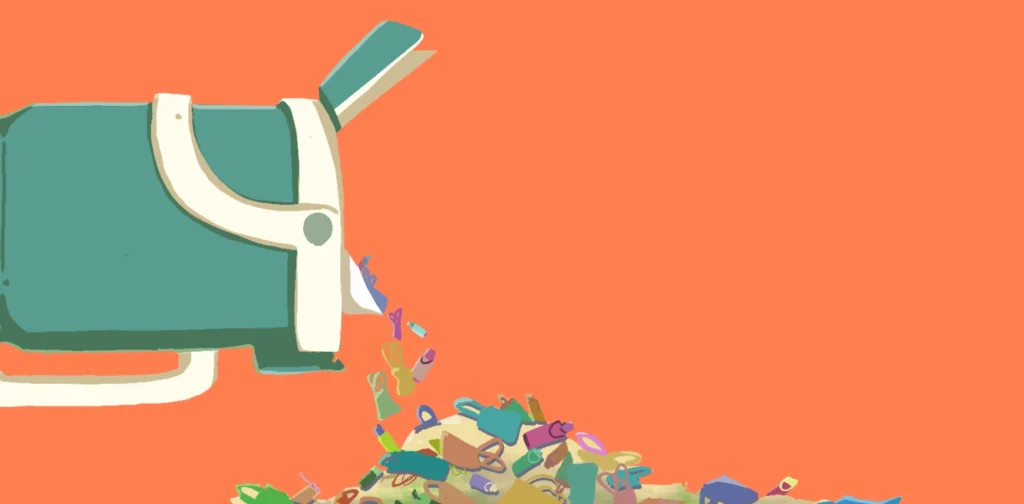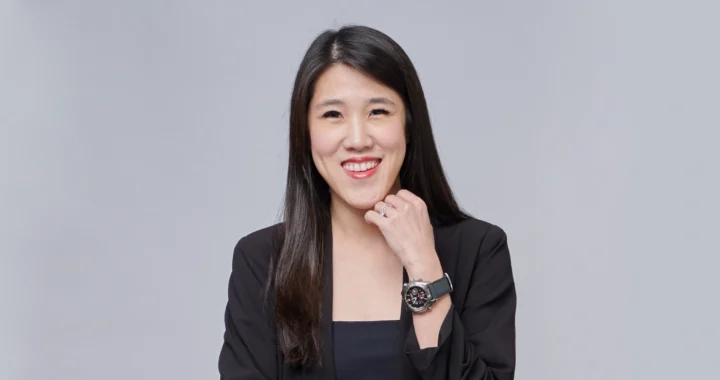When Green Turns Excessive: The Overproduction and Overconsumption of Reusables

Illustration by Frendy Marselino.
From eco-themed wedding souvenirs in Jakarta to community refill programs in Manila, reusable tumblers and tote bags have increasingly become symbols of sustainable living across Asia. Governments, businesses, and campaigns are pushing for “greener” alternatives in place of single-use plastics. Yet in many households, these items accumulate, with unused tumblers in cupboards and piles of tote bags in closets. At some point, the overproduction and overconsumption of reusables will overshadow their potential to cut waste and emissions.
Reuse Frequency Determines Impact
The environmental benefit of any reusable product depends on how often it is used. For instance, single-use plastic bags made from high-density polyethylene (HDPE) have a lower production footprint than reusable bags. Their issue lies in their short-term use by design, leading to a massive amount of production and usage. Moreover, they do not completely degrade as waste yet are rarely recovered.
On the other hand, a cotton or nonwoven polypropylene bag (the most common type) may need more than dozens of uses before achieving a lower carbon footprint than a plastic bag. Life-Cycle Assessment (LCA) studies consistently demonstrate that reusable shopping bags must be used multiple times to offset the higher resource use and emissions associated with their production.
The same principle applies to tumblers and other “eco” items. These products can still create significant environmental burdens if consumers and producers fail to commit to sufficiency, durability, and recovery at scale.
How Culture and Commerce Drive Overconsumption
There is a trend shift—or at least willingness—toward sustainable lifestyle. Still, most “sustainable” products are, at this point, accessible only for healthy, able-bodied, upper- and middle-class communities. Across Asia, these “eco-friendly” items are widely marketed as symbols of environmental awareness. In practice, however, they often end up as part of growing personal collections.
Social media trends amplify the issue. Influencers and everyday users proudly showcase rows of colorful tumblers or stacks of neatly folded reusable bags. While perhaps intended to inspire sustainable choices, these displays can encourage overconsumption by shifting the focus from using to owning.
This pattern reflects moral self-licensing. When consumers purchase something perceived as “eco-friendly,” they feel to have already contributed positively. In turn, it makes it easier to justify the next purchase. For reusable items, this weakens the motivation to maximize use, undermining the benefits that life-cycle assessments emphasize.
In tandem, businesses are also responsible for this greenwashing. From seasonal launches to the push to “buy, buy, buy”, they constantly promote overconsumption while hiding behind the green mask of selling eco-friendly products.
Policy and Infrastructure Gaps Across Asia
Indonesia generates a substantial volume of waste each year, with plastics making up a significant share. In response, several provinces and cities have restricted single-use plastics. At the national level, the “Roadmap Design for Waste Reduction Through Reuse by Producers” establishes a circular economy framework that emphasizes reduction, reuse, and recycling.
However, such policies have limited impact without systems that ensure frequent use and effective recovery. In many Indonesian communities, waste banks (often run as grassroots, community-led initiatives) prioritize high-value materials such as PET bottles and cardboard. Lower-value reusable items like nonwoven polypropylene bags are frequently excluded because of low market demand and limited processing capacity. Without practical recovery pathways, widely distributed reusables can add to existing waste streams instead of offsetting its production impacts.
Similar challenges are evident elsewhere in Asia. In the Philippines, community-led refill initiatives have shown promise but remain small in scale. Meanwhile, in Vietnam, pilot programs on reuse and refill are emerging, yet the recycling sector continues to prioritize high-value materials, leaving everyday reusables without end-of-life options. These examples highlight how both policy efforts and grassroots innovations can be undermined by infrastructural gaps.
From Novelty to Sufficiency: What Good Looks Like
Addressing overconsumption requires a shift from novelty to sufficiency. For consumers, the best thing to do is to maximize the use of products already owned. One durable tumbler or a sturdy tote bag used daily for years provides more benefit than multiple versions used occasionally.
For businesses, this means following design principles that emphasize durability, repairability, and fit with the capabilities of local recovery systems, aligned with the Circular Economy Action Plan (CEAP). Reducing unnecessary seasonal updates, using standardized parts, and choosing recoverable materials make products easier to maintain, repair, and recycle. This ensures they last longer and are recovered effectively at the end of their lifespan.
For policymakers, Extended Producer Responsibility (EPR) schemes can demand producers’ accountability for the entire life cycle of their products. Across Southeast and East Asia, countries are introducing EPR as part of their circular economy strategies. When paired with investments in refill stations, repair facilities, and community-led collection, EPR can help extend use and support effective recovery.
Shifting the Measure of Success
Eco-friendly products should be a solution, not a new source of waste. Replacing single-use plastics with greener alternatives is not, on its own, a sustainable solution. After all, the real measure of success is not how many “green” products circulate, but how long they are used until the end of their lifespan.
Real progress depends on a deeper shift toward changes in mindset and lifestyle. Thus, consumers, businesses, and governments need to embrace sufficiency and responsibility if reusables are to fulfill their promise. Ultimately, it is the commitment of all parties that will determine whether efforts to reduce waste truly bring change or merely become a passing trend.
Editor: Nazalea Kusuma
IS2P Column is a dedicated content platform of the Indonesian Society of Sustainability Professionals (IS2P) in collaboration with Green Network Asia. IS2P Column provides space and editorial support for IS2P members to disseminate their practical insights, experiences, and wisdom, aiming to promote sustainability education in society.
Partner with Green Network Asia:
Launch and publish a dedicated content platform “Column” under your organization’s name, and benefit your leadership & management team, employees, and members of your community with publication credits and editorial support from Green Network Asia, including curation, editing, visual design, publication, and dissemination services.

Join Green Network Asia Membership
If you find this content useful, support Green Network Asia’s movement to create positive impact for people and the planet through public education and multi-stakeholder advocacy on sustainability-related issues and sustainable development. Get exclusive benefits for your personal and professional development.
Become a Member NowNadia Andayani
Nadia is the Strategy Director at ImpacThink, a sustainability communication consultancy. For over 15 years, she taught consumer behavior at Universitas Indonesia, an experience that sparked her deep interest in sustainable consumption. Combining academic insight with strategic communication expertise, she is committed to raise awareness and empower action.


 Building Heat Resilience Amidst Rising Risk in the Asia-Pacific
Building Heat Resilience Amidst Rising Risk in the Asia-Pacific  Sounds Right and Recognizing Nature as an Artist for Biodiversity Conservation
Sounds Right and Recognizing Nature as an Artist for Biodiversity Conservation  Statewide Treaty Bill: Australia’s First Treaty with the Indigenous Australians Passed in Victoria
Statewide Treaty Bill: Australia’s First Treaty with the Indigenous Australians Passed in Victoria  Involving Coastal Communities in Tackling Ghost Nets Pollution
Involving Coastal Communities in Tackling Ghost Nets Pollution  An Interview with Jasmin Lim, Chief Marketing Officer at BH Global
An Interview with Jasmin Lim, Chief Marketing Officer at BH Global  The Monsoon Wind Power Project Supports Energy Transition Across Borders in Southeast Asia
The Monsoon Wind Power Project Supports Energy Transition Across Borders in Southeast Asia